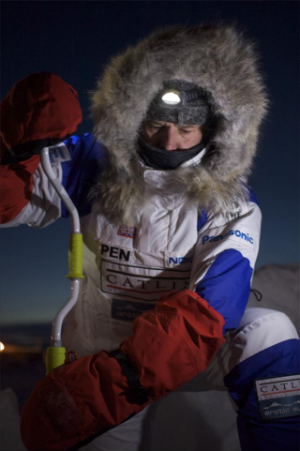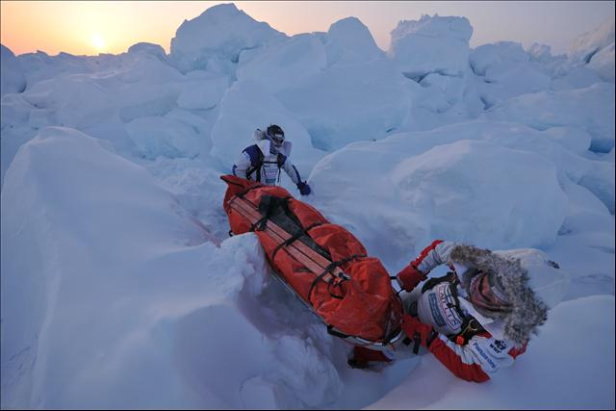 To study the conditions of sea ice, one must walk very carefully across it. Here, two members of the Catlin Arctic Survey team maneuver a supply sled through a rough patch.Courtesy Catlin Arctic Survey
To study the conditions of sea ice, one must walk very carefully across it. Here, two members of the Catlin Arctic Survey team maneuver a supply sled through a rough patch.Courtesy Catlin Arctic Survey
To millions around the world, Pen Hadow — the first person ever to trek to the North Pole alone without any support — is simply one of the most extraordinary people alive. To me, however, he is also the man who didn’t come to dinner.
Let me explain. One day last year Pen arranged to come to our village for dinner with me and the local Member of Parliament who was also, at the time, the shadow minister of the environment. The MP and his wife, Peter and Claire Ainsworth, got ready to host him in their home, only to receive a message that he was physically unable to get there.
So my wife and I had a convivial evening alone with the Ainsworths, all of us much amused that the man who had unhesitatingly taken to his feet when a ski broke two thirds of the way to the Pole — and who had frequently swum through freezing waters when they barred his way — had been unable to make it through England’s placid home counties.
To be fair, I seem to remember that there was a reason for his inability to show, and he did turn up for tea with us a few weeks later. Hadow then told us of an expedition he was trying to finance to measure the condition of the Arctic’s ice. He was anxious to get the job done this year so that the results could be presented to December’s vital climate change negotiations in Copenhagen.
It takes quite a lot to deter a man who once banged an attacking polar bear over the head with a saucepan (“The ‘boing’ on its skull freaked it out and made it run”, he recalls.) Inevitably, Hadow pulled off the new expedition, with support from Prince Charles, the World Wildlife Fund and the United Nations Environment Programme.
So, with his mission just completed, I rang him up at the weekend while he was recovering in Ottawa to ask out how it had gone. He described the task he and his equally intrepid companions — fellow Brits Ann Daniels and Martin Hartley — had just completed as being “hunter gatherers for information.” And, indeed, the data they brought back is badly needed.
Satellite imagery shows that the extent of the polar ice cap is shrinking dramatically — at a rate of about eleven percent a decade since 1979 (losing an area the size of Alaska in 2007 alone). But the thickness of the ice is also vitally important, and neither satellites nor submarines are very good at measuring it. The only real solution is to get out and do it on the ground, or rather on the ice, and that’s a job for someone like Rupert Nigel Pendrill Hadow (to relay his full name).
 Pen Hadow works the manual ice drill the team had to resort to after their ice-penetrating radar kit malfunctioned.Courtesy Catlin Arctic SurveyHe and his team set out from northern Canada in early March to walk 1,200 kilometers to the North Pole, dragging behind them an ice-penetrating radar kit that would measure its thickness every ten centimeters of the way. To their “huge frustration,” the device failed to work for most of the way and they had to rely instead on boring holes in the ice and using an adapted tape measure.
Pen Hadow works the manual ice drill the team had to resort to after their ice-penetrating radar kit malfunctioned.Courtesy Catlin Arctic SurveyHe and his team set out from northern Canada in early March to walk 1,200 kilometers to the North Pole, dragging behind them an ice-penetrating radar kit that would measure its thickness every ten centimeters of the way. To their “huge frustration,” the device failed to work for most of the way and they had to rely instead on boring holes in the ice and using an adapted tape measure.
The results were surprising. Hadow told me that he had been advised by some of the world’s leading experts that their route would mainly take them over “multi-year” ice that had long been there, failing to melt in the summer. But as it happens, Hadow went on, only two of the team’s 1,500 bore holes found multi-year ice. Virtually all the rest, at an average of 1.774 meters thick, turned out to be “first year ice” that had only frozen this past winter, and — since the Arctic sea ice moves around — had presumably drifted onto the line of their trek.
That, in itself, does not reveal a great deal about the thickness of the ice-cap. Indeed, what the measurements did show was slightly reassuring. For example, said Pen, “it was thicker than would be expected for first year ice at this stage of the season,” suggesting that “this could be a recovery year” in the Arctic — at least for the time being.
But it will have revealed valuable scientific data that will now be analyzed by Prof. Wieslaw Maslowski of the U.S. Naval Post Graduate School, one of the more pessimistic authorities on the Arctic ice.
Naturally, there were some narrow escapes for Hadow and team, most notably when they woke at 3:15 a.m. one morning to find the ice floe on which they had camped was beginning to break up. Somehow, with the aid of torches in the pitch dark, they managed to find the single two-foot wide spot where their floe abutted a neighboring one, allowing them to escape in time.
So perhaps it’s not too much to hope that Hadow will manage to find his way back to our village to report back in full on his recent adventure After all, he has still to have that dinner.
—
Video: Pen Hadow discusses sea ice conditions during 2009 mission:
Video: NASA animation of sea-ice changes over the past three decades (via WWF YouTube channel):



